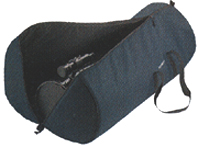Orion Introduction
Orion Accessories
![]() News
News ![]() Products
Products ![]() Pricing
Pricing ![]() Distribution
Distribution ![]() Notes & Interesting Articles
Notes & Interesting Articles
![]()
![]()
![]() Mounts
Mounts
![]() Telescopes
Telescopes
![]()
Orion 120mm ED (4.7 Inch) f7.5 Apochromatic Refractor
Faster and about the same physical length as the Orion 100mm ED, and still incredibly light weight!
Above: Similar Orion 100mm ED Apochromatic Refractor Telescope.
Available as an Optical Tube Assembly as shown above with 2" Focuser and Reducer to 1.25" (61,288 Bytes).
Click on image to see enlarged view (99,351 bytes)
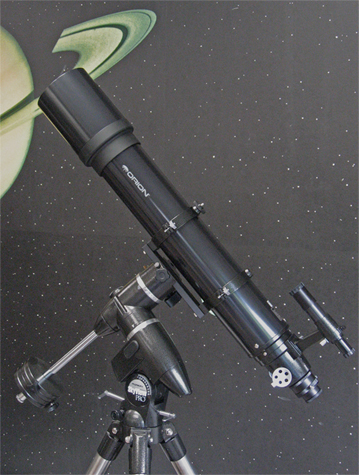 The Orion 120ED telescopes went on display in Company Seven's showroom in September 2006; again we were the first in the nation (maybe in the world) to show a new upper end Orion telescope.
The Orion 120ED telescopes went on display in Company Seven's showroom in September 2006; again we were the first in the nation (maybe in the world) to show a new upper end Orion telescope.
The introduction in late 2003 of the Orion 80mm ED telescope was greeted with much praise and enthusiasm. The Chinese maker contracted by Orion to produce this new telescope proved China was becoming a force to be reckoned with, in some terms tickling the more upscale market areas of optics. The 80 ED demonstrates it is possible to buy a telescope that does not claim to be the finest in the world but is one heck of a good balance between aperture, focal length, overall optical performance and cost. Not long after the introduction of the 80 ED we assumed the design would be scaled up to produce a telescope with a larger aperture, one that would be even more suited for astronomical applications and in 2004 Orion introduced the Orion 100mm ED telescope. In response to the demands for even greater light gathering power to make an Apo even more useful on deep sky objects, the 120 ED was revealed. The 120 mm is sold as an optical tube assembly only, one has to add Finderscope and Mounting Rings and other accessories as desired.
right: Orion 120mm ED OTA on optional SkyView Pro™ mount, with optional Finder and Mounting Rings (184,571 Bytes).
Click on image to see enlarged view (438,238 bytes)
This is not simply a larger version of its predecessors but a different design that provides an incredibly compact arrangement - even shorter than the Orion 120mm f8.3 Achromat that had previously been their largest refractor.
Orion developed the ED telescope lens design so that it can be readily produced solely for Orion and deliver a rewarding experience on the planets or deep sky. It is available when sold separately as the 100 ED Optical Tube Assembly (OTA) and Company Seven also offers it packaged with a variety of mounts including the Orion SkyView Pro™ or Sirius™ "Go To" computer controlled German Equatorial Mounts.
The low cost of the telescope is made possible in part by the low wages paid in China, the ready supply of cheap crown glass, and to degrees of automation and speed in manufacture. This process produces a lens made to a prescription that is good enough to provide views free of false color that are acceptable at up to about 60x per inch of aperture which is somewhat less than premium Apos. So while this is not as esoteric in deign or as perfect an optical figure as our most advanced Apos such as the Astro-Physics 130 f6 and TeleVue NP127 f5.2 Apos, the cost of the complete Orion 120 mm ED telescope and mount represent a good value being only a fraction of the cost of its superior cousins: one gets to that point where sheer size makes up for some qualitative differences!
The 4 inch (10cm) Apo refractor has long been regarded as the most perfect single telescope providing the best compromise of portability and usefulness in amateur astronomical applications. The Orion 120 ED makes up with aperture what it make lack in perfection, and yet with the 900mm focal length the useful fields of view are broad enough and the high power performance good enough that anyone who buys this should be pleasantly surprised.
This Apo can 1. deliver the light gathering and high contrast resolving power necessary to reveal many celestial objects with a very natural almost three dimensional appearance, 2. can provide a wider span of Field of View than any Reflecting or Catadioptric design with an aperture that can show similar detail, and 3. can cross to well above the critical 200x minimal threshold of planet and lunar observing that reveals subtle details and changing features from night to night.
The 120mm ED approaches 280x in term of light gathering power over the unaided human eye and this is about a 1.44X increase over the throughput of its smaller cousin the Orion 100mm ED. It is possible to glimpse the entire "Messier Catalog" and a number of "Hershel Catalog" deep sky objects even from reasonably moderately light polluted suburban skies. One of the finest advertisements ever published for the smaller 4 inch Apo telescope is the book Deep-Sky Companions: The Messier Objects by Stephen O'Meara. To produce the highly detailed drawings of these deep space objects Stephen observed with an older generation TeleVue "Genesis" telescope of 500mm f5 with Fields of View approaching 5 degrees! This book is among the best advertisements for the versatile, readily transportable fast refracting telescopes. He equipped the telescope with only a modest selection of accessories: TeleVue 22mm "Panoptic" eyepiece 23X, 2.85 Degrees Actual Field of View), a 7mm Nagler eyepiece (71X, 1.08 AFOV), and a TeleVue Barlow lens to increase the magnification by 1.8X. The 120mm ED views can surpass those shown in O'Meara's book although it can not attain as wide a field of view as the Genesis, but for many who seek their first practical Apo the 120mm ED will do nicely. And if one is willing to step up to the effort of setting up a German Mount, then this is even more reason to put manageable aperture on that platform.
Company Seven recommends the 120mm ED for variety of applications including:
- Astronomy
- versatile low to medium power visual telescope (16X to 300X)
- photo-guide telescope
- astrograph (with optional Field Flattener/Telecompressor better than 3 degrees!)
- Terrestrial
- Low Power, Wide Field Terrestrial observing
- Use as a versatile Ultra-Telephoto Lens (720mm f/6, 900mm f/7.5 or greater)
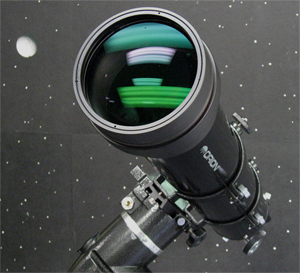 ED Glass the air spaced doublet objective lens of the 120 mm ED is designed to provide precise optical color correction, and it is multicoated to improve contrast and transmission across the visual spectrum. The objective lens incorporates an Extra-Low Dispersion Fluorocrown FPL-53 extra-low dispersion "ED" optical glass from Japan; this is a glass crown element developed under laboratory conditions. Colors of the spectrum have differing wavelengths, to see this notice how in a normal optical glass prism the red and blue rays are bent at slightly different angles as they pass through. This dispersion results in color fringing that when looking through a telescope or telephoto lens usually appears as a slight violet halo around one object that contrast one against the other, and this can cause an overall lack of sharpness. In camera normal and wide-angle lenses this is imperceptible or can be corrected with other techniques, but telescopic lenses magnify the variation in focus between red and blue light rays. So the camera lens making companies (Carl Zeiss, Nikon, and Canon) pioneered Extra-Low Dispersion glasses and Fluorite crystal technologies to solve this problem. This ED glass material provides reduced chromatic aberration over similar f ratio achromatic designs in portions of the spectrum from the D (yellow), through C (red), F ( blue) and G (purple) Fraunhofer lines.
ED Glass the air spaced doublet objective lens of the 120 mm ED is designed to provide precise optical color correction, and it is multicoated to improve contrast and transmission across the visual spectrum. The objective lens incorporates an Extra-Low Dispersion Fluorocrown FPL-53 extra-low dispersion "ED" optical glass from Japan; this is a glass crown element developed under laboratory conditions. Colors of the spectrum have differing wavelengths, to see this notice how in a normal optical glass prism the red and blue rays are bent at slightly different angles as they pass through. This dispersion results in color fringing that when looking through a telescope or telephoto lens usually appears as a slight violet halo around one object that contrast one against the other, and this can cause an overall lack of sharpness. In camera normal and wide-angle lenses this is imperceptible or can be corrected with other techniques, but telescopic lenses magnify the variation in focus between red and blue light rays. So the camera lens making companies (Carl Zeiss, Nikon, and Canon) pioneered Extra-Low Dispersion glasses and Fluorite crystal technologies to solve this problem. This ED glass material provides reduced chromatic aberration over similar f ratio achromatic designs in portions of the spectrum from the D (yellow), through C (red), F ( blue) and G (purple) Fraunhofer lines.
Left: Business end of the Orion 120mm ED OTA (91,020 Bytes).
Click on image to see enlarged view (363,312 bytes)
This technical materials improvement improves one of the critical aspects of refractor performance: reduction of chromatism. This means when one looks through the 120mm ED to a study a black bird contrasted against a light blue sky, or a green leaf in the distance, or the planets or Moon overhead then there is no perceptible false color fringing or violet halo around these objects; the colors are more properly rendered and finer details are seen. And since the colors ore more precisely brought to focus, then the color intensity is better - the more subtle variations in the tonality of the bands on Jupiter are more obvious, and fainter stars may be revealed than in a similar aperture achromatic telescope.
What does it do? the Apochromatic refractor has been the traditional choice of visual astronomers. The combination of thermal stability, best view per pound of telescope, clear high contrast images, and apparent brightness can surpass more bulky designs such as the 8" Catadioptric and Newtonian telescopes. And the versatility of field of view and range of magnification is unrivaled by all other telescope designs.
A real, and relatively affordable multipurpose telescope...
This portable telescope provides stunning lunar and planetary observing; it can clearly reveal the major changing features on several planets through out observing seasons. You may imagine you are seeing details on the moon as if you were in orbit - even though the smallest object you could see with this telescope will actually be about 6 kilometers in diameter! And yet it is so compact and lightweight that a child can manage it.
The focal length of the 120mm ED is made even shorter, and the image quality improved with the optional focal reducer offered by Company Seven to our 120mm ED customers. This photograpic accessory delivers a wider field of coverage at f6 for terrestrial or astrophotography. These and out other Telecompressors provide added versatility for CCD imaging too!
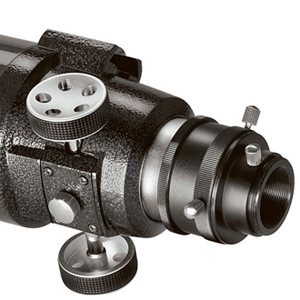
left: Orion ED telescope locking 2" Focuser and Reducer to 1.25". Notice the innovative arrangement of the Focuser Lock, this prevents marring the drawtube as is common with many other telescopes (52,574 Bytes).
Click on image to see enlarged view (88,227 bytes)
2 inch Focuser aside from good performance at higher magnifications the telescope is quite at home sweeping the Milky Way, or Comet hunting. This is an easily manageable telescope with the unobstructed 120mm light gathering power and fields of view to recognize many of the popular bright deep sky objects. Tease subtle details out of the Great Nebula in Orion, see the spiral nature of the Andromeda Galaxy. Seek out more deep-sky wonders including Star Clusters, and Planetary Nebulae, etc. Try a TeleVue 55mm Plossl eyepiece on for size, working at 16x provides a true field of 2.9 degrees. The combination of field of view and light gathering power will make hunting the large deep sky objects very rewarding, even more so with optional light pollution rejection filters. Or take the plunge into awesome perfection of the TeleVue 35mm Panoptic at 26X showing 2.45 degrees - suitable for astronomy and nature watching, with a view that is crystal clear across the entire field of view!
Notice the innovative arrangement of the Crayford style Focuser and Lock; this a low maintenance friction drive which eliminates the conventional focuser's use of a Rack and Pinion and need for lubricants. The four adjustable set screws applies pressure to the Focuser Pinion to attain the proper adjustment of the friction control, this adjustment is critical. And a Drawtube Lock is also provided for astrographic applications.
120mm ED telescope lightweight, yet adequate mechanical construction of metal and aluminum:
- Machined Aluminum, Satin Black Painted Front Cell
- Cast Aluminum, Gray Textured Painted Focuser
- Rolled Steel, Metallic Gray Painted Optical Tube
- Fully Baffled with interior finished in AR Black
- 2" diameter rack and pinion focuser. Moves with smoothness and precision, with no hint of backlash or play
- Focuser draw tube includes reducer to accept furnished 1.25" (31.7mm) accessories
- Focuser tension adjusting/locking screws permit the user to secure focus with heavy loads attached (such as a film or CCD camera) so that focus will not accidentally change over the course of an exposure or viewing session
- Quick Release Bracket for optional Orion Finder
- Dew Shield - threads on and is easily removed
- Slip on Lens Cover with 52mm diameter on axis Aperture Stop
- One year Limited Warranty
* To attach the 120mm ED telescope onto an equatorial mount or other platform we offer optional Mounting Rings, these are sold by the pair. These hinged rings clamp onto the telescope optical tube and are secured with a hand knob. We offer Rings for simple visual uses, or more sophisticated rings with platforms drilled and tapped to accept accessories including photoguide telescopes. All our Rings can be bolted onto a Dovetail Plate to facilitate quick installation and removal from most of the mounts we recommend for the telescope. The optional carrying bag that we offer for our 120mm ED's will fit the telescope with Rings and our typical Dovetail Plate attached. Please contact us to discuss the available choices.
There is enough glass in this lens that one should plan to let the telescope reach thermal equilibrium when taking the telescope from a warm room into a cold location. To reach its best performance, the telescope may require only minutes or an hour or more depending on the amplitude of the temperature change.
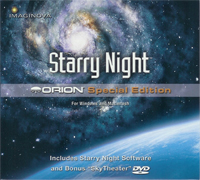 Receive a FREE Starry Night Special Edition software suite. Both the highly acclaimed planetarium software by Imaginova "Starry Night Special Edition" with a bonus "SkyTheatre" DVD are included FREE with purchase of any Orion-brand astronomical telescope from Company Seven.
Receive a FREE Starry Night Special Edition software suite. Both the highly acclaimed planetarium software by Imaginova "Starry Night Special Edition" with a bonus "SkyTheatre" DVD are included FREE with purchase of any Orion-brand astronomical telescope from Company Seven.
"Starry Night Special Edition" is a basic version of the more capable "Starry Night" version 5.0 astronomy software series; this software will help you learn the night sky, see what is up day or night, now or in past millennia, plan your observing sessions, and print out charts and information about the celestial wonders. The set also includes "SkyTheatre", a DVD by Imaginova so your television or PC becomes a spaceship on a voyage through our Solar System. The set is compatible with both Macintosh computers running OSX version 10.3 or later, and with Windows XP for PC. Your personal planetarium and guide to the night sky!
Left: CD-ROM "Starry Night Special Edition" with bonus "SkyTheatre" DVD suite (43,322 bytes).
Click on image to view enlargement (85,180 bytes).
PUTTING A SYSTEM TOGETHER: As you read this, keep in mind that the 120mm ED is sold as a bare optical tube assembly. So in order to complete a telescope system to the point that one may be able to really begin to enjoy a telescope such as this generally requires at least:
-
a) Telescope Optical Tube Assembly (OTA)
-
MOUNTS: Regarding a choice of a suitable mount there are two basic arrangements. The choice may be a matter of convenience, or how you intend to use the telescope:
Alt azimuth: These mount heads can be relatively lightweight, easy to set up and use, can be fitted to a heavy duty rigid photographic Field Tripods, and are well engineered to provide years of good service. These are a first choice for uses which include terrestrial panoramic observing since the alternative German Equatorial mount is unwieldy in such applications. However, for some uses in astronomy such as when one approaches those magnifications necessary to see meaningful details on the planets, or when sharing a telescope among numerous observers it becomes more and more challenging to precisely manually move the Alt Azimuth mount smoothly and simultaneously in elevation and azimuth.
Equatorial: this is our first choice of mount for the 120 ED since this telescope affords a notable increase in focal length and accordingly in physical length. Considering it is most likely to be used in astronomical applications we believe most amateurs will prefer it on a German Equatorial Mount. The German Equatorial mount can be motorized to permit automated tracking of celestial objects moving across the night sky. So to observe the planets or do other operations which require high magnifications, or if you wish to share the telescope with several others (especially young children), or if you hope to become involved in astrophotography, then we do suggest you place the telescope onto a that will provide the capability to stay on a target in the sky.
Company Seven does offer a good selection of practical and affordable German Equatorial Mounts for the 120 ED, you may wish to start off considering a suitable economical German Mount such as the Orion SkyView Pro system, or if you prefer a better tracking mount with more advanced electronics then we suggest our other Orion, Losmandy, or Vixen made mounts. The German mounts are heavier and more complicated to set up and use than most Alt azimuth mounts, and so some people may find there is no one perfect solution for every problem and they may wish to have both types of mount in time.
b) German Equatorial Mount with Tripod
c) Portable rechargeable Power Supply (for the German mount if furnished with motors)
Highly desirable accessories for telescopes such as this include:
d) High magnification (about 200X telescope) eyepiece for views of the planets
e) Low magnification eyepiece (for views of the faint deep sky objects)*
-
This may necessitate an upgrade to a 2" Diameter Mirror Diagonal
with the associated fittings.
f) Middle Magnification eyepiece - usually between 80 to 120X, for views of the full Moon, Sun, Star Clusters, etc.
g) Neutral Density Filters for viewing Moon, planets (usually set of two)
h) Guide book (with Red L.E.D. flashlight for reading in low light)
i) Mirror Diagonal: refracting telescopes when furnished with a right angle mirror diagonal provide the sharpest and most clear image through a telescope. The image is correct right side up, but is reversed left to right. Few people using this for nature watching complain about this since the view is notably better at higher magnifications which may be used occasionally for birding and more often in astronomy.
Those telescopes provided with the optional 45 degree angled image erecting prism diagonal provide images which are correct right side up, and left to right. This tends to be selected by few of our customers, including nature watchers since the view is less crisp and clear (than the mirror diagonal) at higher magnifications which may be used occasionally for birding and more often in astronomy. The prisms do not tend to illuminate the full field of view of low magnification oculars (such as the 32mm Plossl), and so some vignetting may appear obvious at the edges of the field of view. These prisms can not support 2" oculars.
The telescopes furnished with our optional 2 inch diameter right angle mirror diagonal (or Zenith Prism) provide the combination of the sharpest and most clear image through a telescope, and this can also accept very wide angle 2 inch diameter oculars, and 48mm threaded filters (polarizing, etc.). This is highly desirable for panoramic views of the country side, large areas of night sky (sweeping through the Milky Way) and observing large Nebulae such as the "Veil" and "North American", etc. The image is correct right side up, but is reversed left to right.
120mm ED TELESCOPE SPECIFICATIONS:
| Clear aperture: | 119.8mm (4.72 inches) |
| Design: | Air Spaced ED Doublet Apo |
| Focal length: | 900 mm (35.4 inches) |
| Resolution (visual): | 1 arc second |
| Coatings: | Multicoated |
| Light Gathering Power: | about 275X that of unaided eye |
| Visual Magnitude Limit: | About 12.7 |
| Magnification range: | 16x to 300x |
| Tube assembly construction: | Painted finish, aluminum tube |
| Tube assembly length w/Dewcap: | 36.6 inches (93 cm) |
| Tube assembly length w/o Dewcap: | 31.9 inches (81 cm) |
| Lens Shield Length: | 6.3 inches (159 mm) |
| Lens Shield OD: | 5.63 inches (143 mm) |
| Lens Cover Aperture Stop: | 2 Inches (52 mm) |
| Focuser type: | 2 inch Crayford |
| Focuser Travel: | 5.3 inches (134.9mm) |
| Weight of OTA: | 10 lbs. 6 oz. (4.7 kg) |
| Packaged Shipping Weight: | 16 lbs. 13.6 oz. (7.6 kg) |
| Packaged Dimensions: | 51 x 10-1/4 x 9-3/4 inches |
| 35mm prime-focus field: | 2.2 x 1.5 x 2.7 degrees @ f9 |
| 35mm field with Focal Reducer: | 2.8 x 1.9 x 3.4 degrees (vignetted) @ f6 |
* Specifications are subject to change without notice.
FURTHER READING
-
To read additional information about the Orion 120mm ED sold by Company Seven feel free to download the Orion SkyView Pro™ 80ED EQ Telescope Instruction Manual. This is the complete 28 page illustrated instruction manual as furnished with our similar 80mm ED telescopes when packaged with the Orion SkyView Pro™ German Equatorial Mount. When the manual is ready for the 120mm ED we will place that on line instead. Publication content by Orion Telescopes and Binoculars, all rights reserved. From Company Seven's Archives. 2,949,488 bytes (in Acrobat Reader ".pdf" format).
COMPANY SEVEN'S QUALITY CONTROL SERVICE:
All of the information we provide on line and by phone, or by E-Mail, with our expertise and our unrivaled showroom and museum (an increasing rare sight), and the fact that one may buy the basic instrument from us or elsewhere at about the same cost should be enough to persuade one to choose Company Seven. However, we do even better; we make it in your interest to buy from us. While Orion has been quite good at having the factories overseas produce a great value, once in a while something less than perfect slips by; a part is not machined just right, something is installed a bit off, a contaminant gets into the lens, or a component is damaged in transit. If you receive one of these telescopes, and if you know enough to recognize an anomaly then it is a simple matter to call Orion for a prompt exchange or replacement parts. We both have very good reputations for after sale support and a money back guarantee.
-
"a series of subtle improvements"
One will never read a sad tale from someone who actually bought their telescope at Company Seven. We are so confident in our QC program that we promise if a telescope sold by Company Seven is ever returned to us with any manufacture related anomaly then we will correct it, return it to you at no charge, and reimburse your costs of returning the instrument for service!
-
"expert counsel brings value to a transaction, and profit should be the reward for a job well done"
SUGGESTED ACCESSORIES
These are optional accessories that are not included with the telescope that we highly recommend for your viewing pleasure and long term success:
- Mounting Rings (pair) - to eliminate possibility of lateral rotation of the telescope, and facilitate piggyback or guide scope payloads.
- Equatorial or Alt-Azimuth Mount: a good quality mount head and tripod or stand will be needed to steadily hold the instrument. An equatorial mount will be preferred for astronomy, more so for those who seek to attain its high magnification potential. A telescope of this high quality deserves a good quality, rigid platform to support it.
- The telescope is provided with no Finder, we suggest ordering either the Orion 9x 50mm Correct Image Finder or a reflex sight such as our compact Rigel Qwikfinder, or the larger Telrad, or the "TeleVue Starbeam" illuminated sight: these will aid one in finding and centering objects in the main telescope and also help one learn the sky by "star hopping" from one object to another.
- Mirror Diagonal: 1.25" diameter or preferably 2" diameter precision mirror so that one can comfortably view celestial objects with low magnification, wide angle eyepieces.
On the matter of an optional Image Erecting Prism, while Company Seven does offer optional 45 degree inclined image erecting prisms these can only accommodate 1.25 inch diameter oculars. There are no image erecting prisms that can fully illuminate the Field Stop of all 2" oculars. Furthermore, erecting prisms will not provide image quality to equal that of a good mirror diagonal and this will become particularly apparent when observing at higher magnifications. However, for moderate to medium magnification applications where one needs correct images (to read distant writing, etc.) then the optional prism may be suitable.
- Eyepieces: Typically astronomers will wish to initially set up the telescope
with at least two or three 1.25" or 2" eyepieces to address:
- Low magnification: for views of the faint deep sky objects a 32mm to 35mm
focal length eyepiece.
- Middle Magnification eyepiece - usually between 80 to 120X, for views
of the full Moon, Star Clusters, etc.
- High magnification: for views of the planets
Fortunately for those on a constrained initial budget, simpler eyepiece designs such as the Plossl, Orthoscopic will work well on this focal ratio telescope. If you prefer to see wider fields of view, and if you require long eye relief (distance from lens to the eye) to accommodate spectacles, then Company Seven recommends eyepieces of advanced designs such as those pioneered by Al Nagler, founder of the TeleVue company. TeleVue's advanced designs include the "Nagler", "Radian", or "Panoptic" series eyepieces. These oculars will provide the widest clear, and flat field images bringing out the most in your telescope (and many other) telescopes. For manually driven mounts in particular, wider field of views are also desirable since as the Earth rotates and objects drift across the field of view, a wide angler ocular shows an object for some time longer before having to adjust the telescope.
Please refer to the brochure and the test report/data from Company Seven enclosed with the telescopes we deliver for detailed characterizations of many suggested eyepieces:
Eyepiece Magnification Actual field of view Exit pupil 55mm Plossl (2" eyepiece) 11x 4.4 degrees 7.3mm 35mm Panoptic (2" eyepiece) 17x 3.7 degrees 4.67mm 32mm Plossl 19x 2.6 degrees 4.3mm 27mm Panoptic (2" eyepiece) 22x 2.9 degrees 3.6mm 22mm Nagler (2" eyepiece) 27x 3 degrees 2.9mm 15mm Plossl 50x 1.2 degrees 2.0mm 8mm Radian 101x 0.59 degrees 0.9mm 6mm Radian 100x 0.6 degrees 0.8mm 5mm Nagler 120x 0.67 degrees 0.7mm 3mm Radian 300x 0.3 degrees 0.4mm - Low magnification: for views of the faint deep sky objects a 32mm to 35mm
focal length eyepiece.
- Guide book: "Backyard Astronomers Guide" or "Nightwatch" by Terrence Dickinson, or "Starware" by Phil Harrington. For the novice from age 8 to 15 or so up to adult. Good introductions to astronomy, the use of telescopes, and their accessories. Easy introductions to finding ones way around the night sky.
-
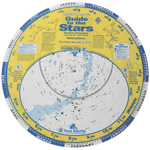 David H. Levy Guide to the Stars Planisphere If you are not familiar with the night sky then Company Seven recommends you buy a good simple Planisphere which makes it very easy for one to find out what constellations and major deep sky objects are overhead at any given time of the day or night.
David H. Levy Guide to the Stars Planisphere If you are not familiar with the night sky then Company Seven recommends you buy a good simple Planisphere which makes it very easy for one to find out what constellations and major deep sky objects are overhead at any given time of the day or night.
The night sky is mapped with the Constellations being those patterns recognizable to man since time immemorial. Constellations can be thought of as countries or states on a world map, where if you seek the Grand Canyon then you know to find Arizona. While in the night sky when one seeks the Great Nebula then one looks toward the Constellation Orion. The Planisphere is a two piece assembly consisting of one disc with a chart of the entire night sky, and an attached overlay disc with a transparent window and surrounding mask to simulate the horizons. The overlay is dialed to line up its local time indicator marks with the Month and Day printed around the edge of the chart disc, and so when properly set this will reveal what parts of the sky may be seen at any time of the year. The print is easy to read under day or red light.
- Red LED Flashlight such as the Rigel Skylite to help one set up and use a telescope, and to read charts or a planishpere without adversely impacting the observers night vision.
- Equalizer: A slip fit machined bronze, heavy 2 to 1.25 inch diameter reducer adapter. Helps to keep telescope balance when switching to and from light and heavy accessories and eyepieces. Particularly helpful when using telescope with Alt-Azimuth mounts.
- Camera Adapter: The Orion 120mm ED is at its best in astronomical applications, but may be used as a terrestrial telescope, or as a Super-Telephoto lens for video or 35mm film uses.
- Focal Reducer: For visual or photographic use - sold as a courtesy ONLY to those who bought their 100ED from Company Seven. Flattens the Field and shortens the effective focal length of the 100ED telescope from 900 mm (f9) to 720mm (f/7.2). Corrector provides 35mm format Fields of view of up to about 3.4 degrees; there will be some vignetting at the corners due in part to the design of T-Adapter rings.
- Neutral Density and Color Filters to reduce the brightness of the Moon and Planets, and highlight subtle features.
- Sky Light Pollution Rejection Filter to reduce the greenish or golden background glow from city lights and darken the sky background - aid seeing faint Nebulae.
- Orion zip up fitted and padded Carrying Bag (example made for an 8 inch Dobsonian telescope is shown at right) for safer, and more convenient transport the telescope optical tube assembly. The carrying handles are offset to allow one to easily balance the rear heavy telescope in the hand or over the shoulder. Keep in mind that these are very convenient and lightweight bags, but are not suitable for shipping a telescope.
- Barlow or TeleVue "Powermate" Lens: Company Seven suggests you consider any of a number of 1.25 inch or 2 inch diameter Barlow lenses that we offer to double or more than triple your magnification. Furthermore, these accessories can project an image farther from the focuser to attain focus with most 35mm SLR cameras, optional accessories such as binocular viewers, etc. Contact Company Seven for suggestions on how to to best meet your goals.
- Telescopes such as this often put the eyepiece at position that is only about 3 or 4 feet (0.9 or 1.2 meters) from the ground. Since most of our customers are taller than that, they will find it uncomfortable to stand bent over to observe for extended periods. For a much more enjoyable and comfortable observing experience, Company Seven recommends the Observing Chair; this is our most comfortable, flat folding, adjustable height seat. It is not inexpensive, but is so practical and can be used for camping or other times when a comfortable portable seat is desired.
